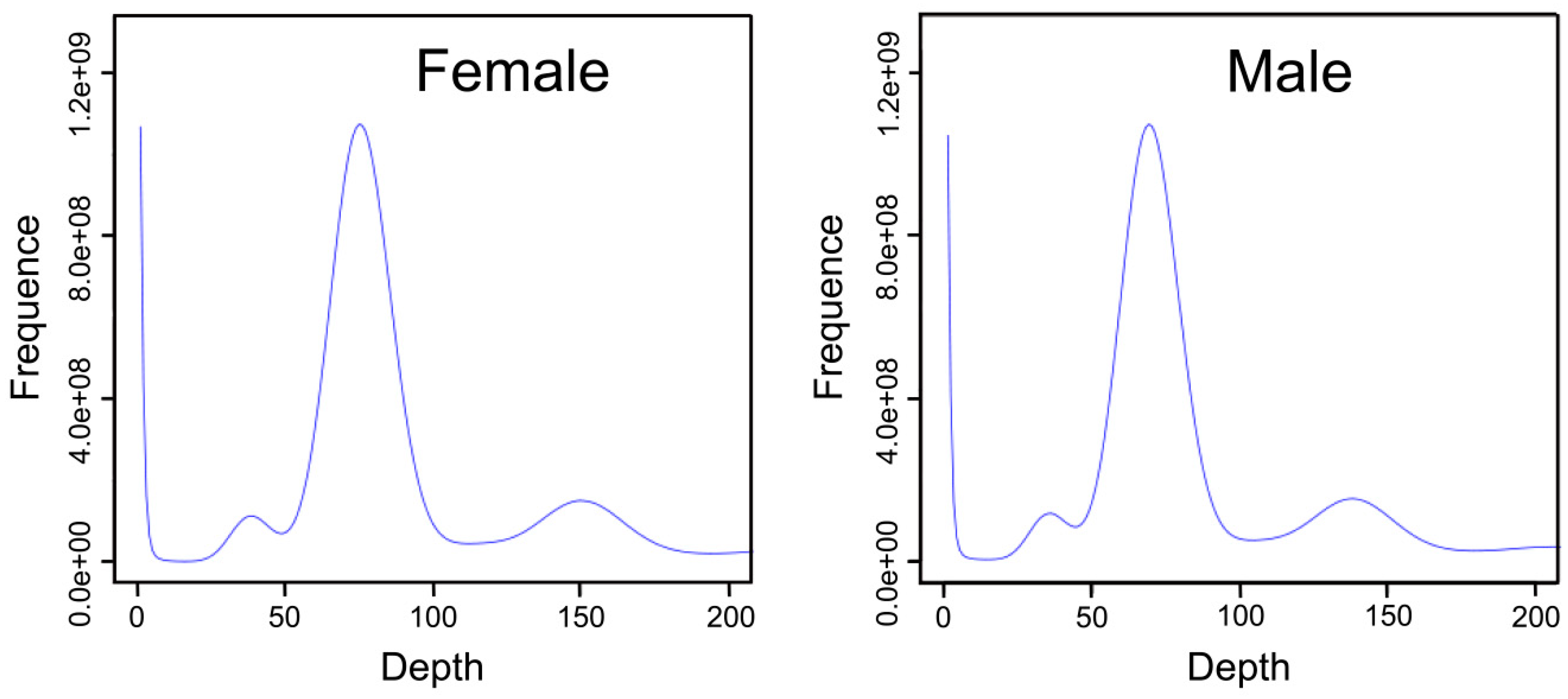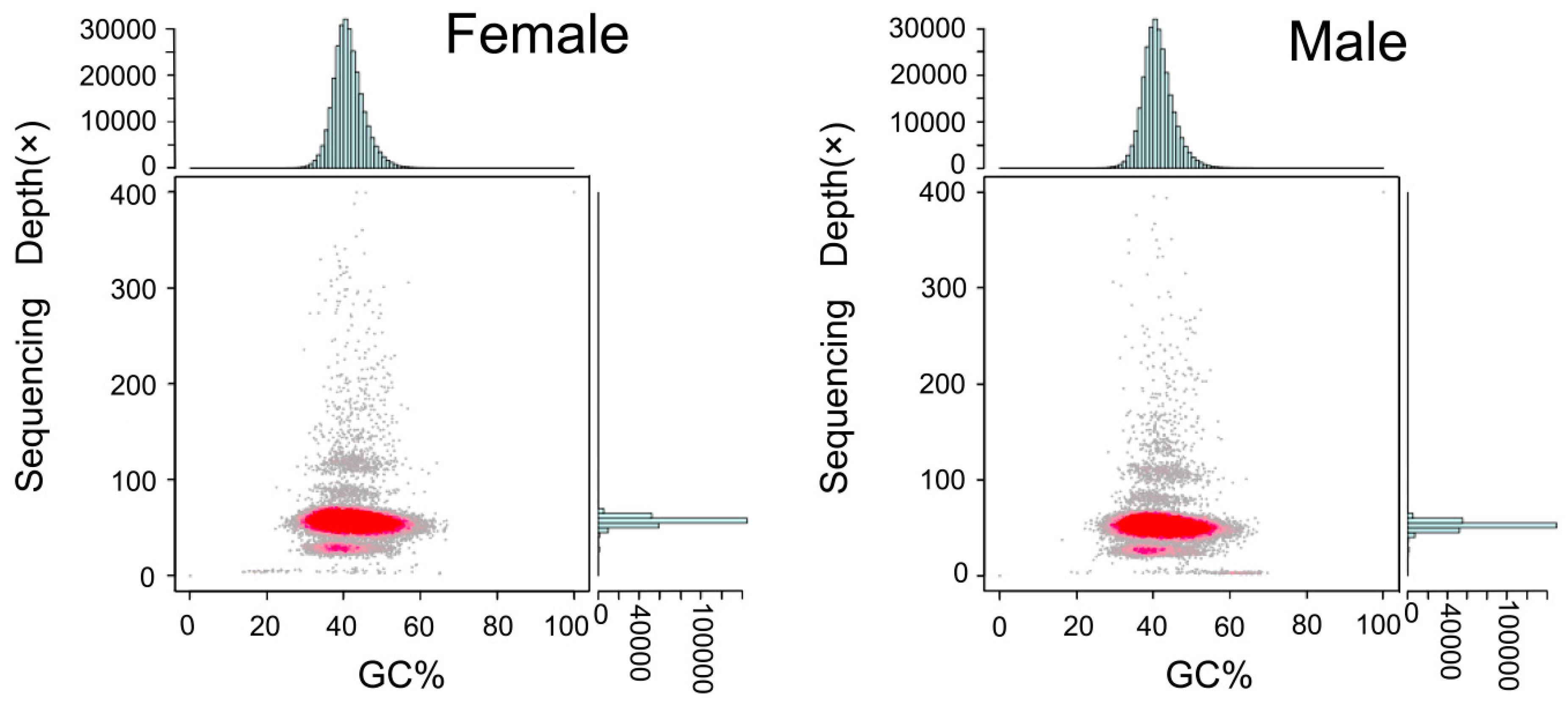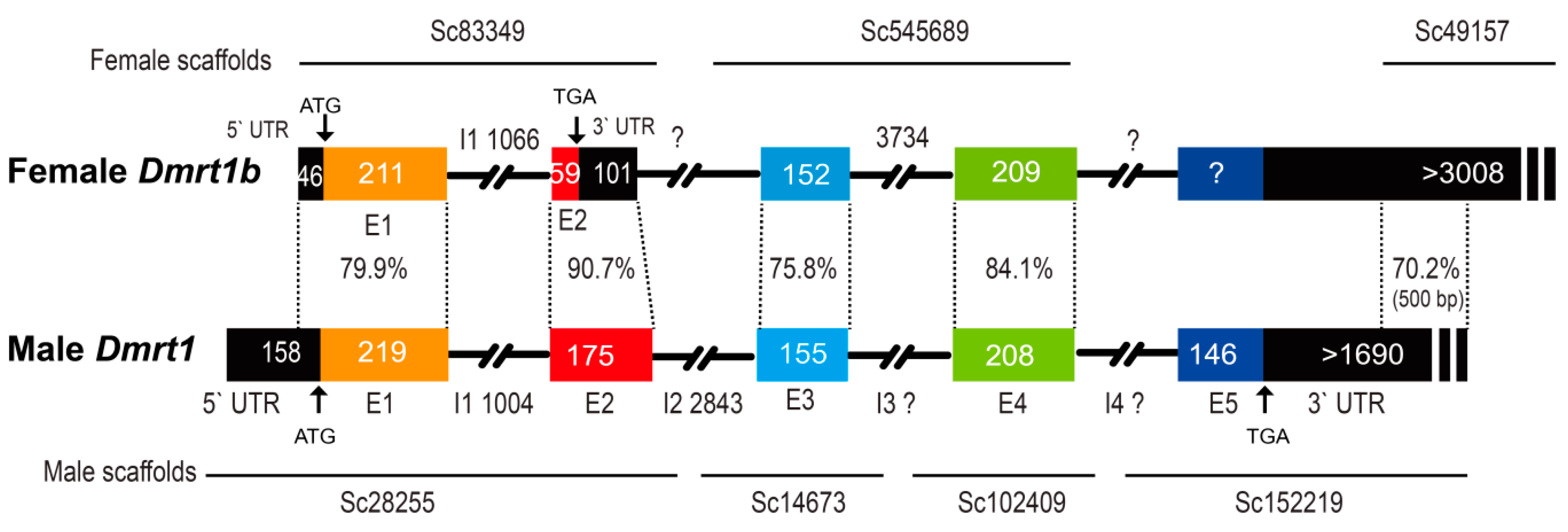Genome Survey of Male and Female Spotted Scat (Scatophagus argus)
Abstract
:Simple Summary
Abstract
1. Introduction
2. Materials and Methods
2.1. Sample and Tissue Collection
2.2. Whole Genome Sequencing
2.3. Genome Size Estimation and Identification of Heterozygosity and Repeat Ratios
2.4. Genome Assembly and GC Content
2.5. Gene Prediction, Annotation, and Assembly Assessment
2.6. Alignment of The Male and Female Scaffolds on Dmrt1s Exons
2.7. Identification of SSRs
3. Results
3.1. Genome Sequencing and Sequence Quality Estimation
3.2. Genome Size, Ratio of Heterozygosity, and Repeats by K-Mer Analysis
3.3. Genome Assembly and GC Content
3.4. Gene Prediction, Annotation, and Evaluation
3.5. Characterization of the Dmrt1s Gene
3.6. Identification of SSR
4. Discussion
5. Conclusions
Supplementary Materials
Author Contributions
Funding
Conflicts of Interest
References
- Gupta, S. An overview on morphology, biology, and culture of spotted scat Scatophagus argus (Linnaeus 1766). Rev. Fish. Sci. Aquac. 2016, 24, 203–212. [Google Scholar] [CrossRef]
- Mathew, A.K. Studies on Some Aspects of Biology of Two Estuarine Fishes Megalops Cyprinoides and Scatophagus argus. Ph.D. Thesis, Cochin University of Science and Technology, Cochin, India, 1988. [Google Scholar]
- Morgan, S. Scats: Personable, hardy garbage disposals for the brackish water aquarium. Trop. Fish Hobbyist 1983, 318, 65–69. [Google Scholar]
- Yang, W.; Chen, H.P.; Cui, X.F.; Zhang, K.W.; Jiang, D.N.; Deng, S.P.; Zhu, C.H.; Li, G.L. Sequencing, de novo assembly and characterization of the spotted scat Scatophagus argus (Linnaeus 1766) transcriptome for discovery of reproduction related genes and SSRs. Chin. J. Oceanol. Limnol. 2018, 36, 1329–1341. [Google Scholar] [CrossRef]
- Shao, Y.T.; Hwang, L.Y.; Lee, T.H. Histological observations of ovotestis in the spotted scat Scatophagus argus. Fish. Sci. 2004, 70, 716–718. [Google Scholar] [CrossRef]
- Barry, T.P.; Fast, A.W. Biology of the spotted scat (Scatophagus argus) in the Philippines. Asian Fish. Sci. 1992, 5, 163–179. [Google Scholar]
- Chang, S.L. Studies on the early development and larval rearing of spotted scat Scatophagus argus. J. Taiwan Fish. Res. 1997, 5, 41–49. [Google Scholar]
- Sivan, G.; Radhakrishnan, C.K. Food, feeding habits and biochemical composition of Scatophagus argus. Turk. J. Fish. Aquat. Sci. 2011, 11, 603–608. [Google Scholar]
- Ghazilou, A.; Chenary, F.; Morovvati, H.; Zolgarneine, H. Time course of saltwater adaptation in spotted scat (Scatophagus argus) (Pisces): A histomorphometric approach. Ital. J. Zool. 2011, 78, 82–89. [Google Scholar] [CrossRef]
- Cai, Z.P.; Wang, Y.; Hu, J.W.; Zhang, J.B.; Lin, Y.G. Reproductive biology of Scatophagus argus and artificial induction of spawning. J. Trop Oceanogr. 2010, 29, 180–185. [Google Scholar] [CrossRef]
- Li, G.L.; Zhang, M.Z.; Deng, S.P.; Chen, H.P.; Zhu, C.H. Effects of temperature and fish oil supplementation on ovarian development and foxl2 mRNA expression in spotted scat Scatophagus argus. J. Fish. Biol. 2015, 86, 248–260. [Google Scholar] [CrossRef]
- Jiang, D.N.; Li, J.T.; Tao, Y.X.; Chen, H.P.; Deng, S.P.; Zhu, C.H.; Li, G.L. Effects of melanocortin-4 receptor agonists and antagonists on expression of genes related to reproduction in spotted scat, Scatophagus argus. J. Comp. Physiol. B 2017, 187, 603–612. [Google Scholar] [CrossRef]
- Jiang, D.N.; Mustapha, U.F.; Shi, H.J.; Huang, Y.Q.; Si-Tu, J.X.; Wang, M.; Deng, S.P.; Chen, H.P.; Tian, C.X.; Zhu, C.H.; et al. Expression and transcriptional regulation of gsdf in spotted scat (Scatophagus argus). Comp. Biochem. Physiol. B Biochem. Mol. Biol. 2019, 233, 35–45. [Google Scholar] [CrossRef]
- Zhang, G.; Wang, W.; Su, M.L.; Zhang, J.B. Effects of recombinant gonadotropin hormones on the gonadal maturation in the spotted scat, Scatophagus argus. Aquaculture 2018, 483, 263–272. [Google Scholar] [CrossRef]
- Mei, J.; Gui, J.F. Genetic basis and biotechnological manipulation of sexual dimorphism and sex determination in fish. Sci. China Life Sci. 2015, 58, 124–136. [Google Scholar] [CrossRef] [Green Version]
- Deng, S.P.; Wu, B.; Zhu, C.H.; Li, G.L. Molecular cloning and dimorphic expression of growth hormone (gh) in female and male spotted scat Scatophagus argus. Fish. Sci. 2014, 80, 715–723. [Google Scholar] [CrossRef]
- Shen, Y.; Yue, G. Current status of research on aquaculture genetics and genomics-information from ISGA 2018. Aquac. Fish. 2019, 4, 43–47. [Google Scholar] [CrossRef]
- Tao, W.J.; Yuan, J.; Zhou, L.Y.; Sun, L.N.; Sun, Y.L.; Yang, S.J.; Li, M.H.; Zeng, S.; Huang, B.F.; Wang, D.S. Characterization of gonadal transcriptomes from Nile tilapia (Oreochromis niloticus) reveals differentially expressed genes. PLoS ONE 2013, 8, e63604. [Google Scholar] [CrossRef] [Green Version]
- Tian, C.X.; Li, Z.Y.; Dong, Z.D.; Huang, Y.; Du, T.; Chen, H.P.; Jiang, D.N.; Deng, S.P.; Zhang, Y.L.; Wanida, S.; et al. Transcriptome analysis of male and female mature gonads of silver sillago (Sillago sihama). Genes 2019, 10, 129. [Google Scholar] [CrossRef] [Green Version]
- Bian, C.; Li, J.; Lin, X.Q.; Chen, X.Y.; Yi, Y.H.; You, X.X.; Zhang, Y.P.; Lv, Y.Y.; Shi, Q. Whole genome sequencing of the blue tilapia (Oreochromis aureus) provides a valuable genetic resource for biomedical research on tilapias. Mar. Drugs 2019, 17, 386. [Google Scholar] [CrossRef] [Green Version]
- Schartl, M.; Kneitz, S.; Volkoff, H.; Adolfi, M.; Schmidt, C.; Fischer, P.; Minx, P.; Tomlinson, C.; Meyer, A.; Warren, W.C. The piranha genome provides molecular insight associated to its unique feeding behavior. Genome Biol. Evol. 2019, 11, 2099–2106. [Google Scholar] [CrossRef]
- He, F.X.; Jiang, D.N.; Huang, Y.Q.; Mustapha, U.F.; Yang, W.; Cui, X.F.; Tian, C.X.; Chen, H.P.; Shi, H.J.; Deng, S.P.; et al. Comparative transcriptome analysis of male and female gonads reveals sex-biased genes in spotted scat (Scatophagus argus). Fish. Physiol. Biochem. 2019, 45, 1963–1980. [Google Scholar] [CrossRef]
- Zhou, W.; Hu, Y.Y.; Sui, Z.H.; Fu, F.; Wang, J.G.; Chang, L.P.; Guo, W.H.; Li, B.B. Genome survey sequencing and genetic background characterization of Gracilariopsis lemaneiformis (Rhodophyta) based on next-generation sequencing. PLoS ONE 2013, 8, e69909. [Google Scholar] [CrossRef]
- Tang, Q.; Ma, X.J.; Mo, C.M.; Pan, L.M.; Wei, R.C.; Zhao, H. Genome survey analysis in Siraitia grosvenorii. Guihaia 2015, 35, 786–791. [Google Scholar]
- Shi, L.L.; Yi, S.K.; Li, Y.H. Genome survey sequencing of red swamp crayfish Procambarus clarkii. Mol. Biol. Rep. 2018, 45, 799–806. [Google Scholar] [CrossRef]
- Yang, X.; Liu, D.; Liu, F.; Wu, J.; Zou, J.; Xiao, X.; Zhao, F.Q.; Zhu, B.L. HTQC: A fast quality control toolkit for Illumina sequencing data. BMC Bioinform. 2013, 14, 33. [Google Scholar] [CrossRef] [Green Version]
- Marcais, G.; Kingsford, C. A fast, lock-free approach for efficient parallel counting of occurrences of k-mers. Bioinformatics 2011, 27, 764–770. [Google Scholar] [CrossRef] [Green Version]
- Chor, B.; Horn, D.; Goldman, N.; Levy, Y.; Massingham, T. Genomic DNA k-mer spectra: Models and modalities. Genome Biol. 2009, 10, R108. [Google Scholar] [CrossRef] [Green Version]
- Liu, B.H.; Shi, Y.J.; Yuan, J.Y.; Hu, X.S.; Zhang, H.; Li, N.; Li, Z.Y.; Chen, Y.X.; Mu, D.S.; Fan, W. Estimation of genomic characteristics by analyzing k-mer frequency in de novo genome projects. arXiv 2013, arXiv:1308.2012v1. Available online: https://arxiv.org/abs/1308.2012v1 (accessed on 20 August 2019).
- Li, X.; Waterman, M.S. Estimating the repeat structure and length of DNA sequences using L-tuples. Genome Res. 2003, 13, 1916–1922. [Google Scholar]
- Luo, R.B.; Liu, B.H.; Xie, Y.L.; Li, Z.Y.; Huang, W.H.; Yuan, J.Y.; He, G.Z.; Chen, Y.X.; Pan, Q.; Liu, Y.J. SOAPdenovo2: An empirically improved memory-efficient short-read de novo assembler. Gigascience 2012, 1, 18. [Google Scholar] [CrossRef]
- Li, R.Q.; Fan, W.; Tian, G.; Zhu, H.M.; He, L.; Cai, J.; Huang, Q.F.; Cai, Q.L.; Li, B.; Bai, Y.Q.; et al. The sequence and de novo assembly of the giant panda genome. Nature 2010, 463, 311–317. [Google Scholar] [CrossRef] [PubMed] [Green Version]
- Parker, S.C.J.; Margulies, E.H.; Tullius, T.D. The relationship between fine scale DNA structure, GC content, and functional elements in 1% of the human genome. Genome Inf. 2008, 20, 199–211. [Google Scholar] [CrossRef] [Green Version]
- Lu, M.; An, H.M.; Li, L.L. Genome survey sequencing for the characterization of the genetic background of Rosa roxburghii Tratt and leaf ascorbate metabolism genes. PLoS ONE 2016, 11, e0147530. [Google Scholar] [CrossRef] [PubMed]
- Majoros, W.H.; Pertea, M.; Salzberg, S.L. TigrScan and GlimmerHMM: Two open-source ab initio eukaryotic gene-finders. Bioinformatics 2004, 20, 2878–2879. [Google Scholar] [CrossRef]
- Conesa, A.; Gotz, S.; Garcia-Gomez, J.M.; Terol, J.; Talon, M.; Robles, M. Blast2GO: A universal tool for annotation, visualization and analysis in functional genomics research. Bioinformatics 2005, 21, 3674–3676. [Google Scholar] [CrossRef] [Green Version]
- Waterhouse, R.M.; Seppey, M.; Simão, F.A.; Manni, M.; Ioannidis, P.; Klioutchnikov, G.; Kriventseva, E.V.; Zdobnov, E.M. BUSCO applications from quality assessments to gene prediction and phylogenomics. Mol. Biol. Evol. 2017, 35, 543–548. [Google Scholar] [CrossRef] [Green Version]
- Mustapha, U.F.; Jiang, D.N.; Liang, Z.H.; Gu, H.T.; Yang, W.; Chen, H.P.; Deng, S.P.; Wu, T.L.; Tian, C.X.; Zhu, C.H.; et al. Male-specific Dmrt1 is a candidate sex determination gene in spotted scat (Scatophagus argus). Aquaculture 2018, 495, 351–358. [Google Scholar] [CrossRef]
- Zhou, W.; Li, B.; Li, L.; Ma, W.; Liu, Y.C.; Feng, S.C.; Wang, Z.Z. Genome survey sequencing of Dioscorea zingiberensis. Genome 2018, 61, 567–574. [Google Scholar] [CrossRef]
- Hinegardner, R.; Rosen, D.E. Cellular DNA content and the evolution of teleostean fishes. Am. Nat. 1972, 106, 621–644. [Google Scholar] [CrossRef]
- Dolezel, J.; Bartos, J.; Voglmayr, H.; Greilhuber, J. Nuclear DNA content and genome size of trout and human. Cytom. A 2003, 51, 127–128. [Google Scholar] [CrossRef]
- Xu, S.Y.; Xiao, S.J.; Zhu, S.L.; Zeng, X.F.; Luo, J.; Liu, J.Q.; Gao, T.X.; Chen, N.S. A draft genome assembly of the Chinese sillago (Sillago sinica), the first reference genome for Sillaginidae fishes. Gigascience 2018, 7, giy108. [Google Scholar] [CrossRef]
- Shao, C.W.; Li, C.; Wang, N.; Qin, Y.T.; Xu, W.T.; Liu, Q.; Zhou, Q.; Zhao, Y.; Li, X.H.; Liu, S.S.; et al. Chromosome-level genome assembly of the spotted sea bass, Lateolabrax maculatus. Gigascience 2018, 7. [Google Scholar] [CrossRef]
- Tine, M.; Kuhl, H.; Gagnaire, P.A.; Louro, B.; Desmarais, E.; Martins, R.S.; Hecht, J.; Knaust, F.; Belkhir, K.; Klages, S.; et al. European sea bass genome and its variation provide insights into adaptation to euryhalinity and speciation. Nat. Commun. 2014, 5, 5770. [Google Scholar] [CrossRef] [Green Version]
- Ao, J.; Mu, Y.; Xiang, L.X.; Fan, D.; Feng, M.; Zhang, S.; Shi, Q.; Zhu, L.Y.; Li, T.; Ding, Y.; et al. Genome sequencing of the perciform fish Larimichthys crocea provides insights into molecular and genetic mechanisms of stress adaptation. PLoS Genet. 2015, 11, e1005118. [Google Scholar] [CrossRef] [Green Version]
- Martinez, P.; Vinas, A.M.; Sanchez, L.; Diaz, N.; Ribas, L.; Piferrer, F. Genetic architecture of sex determination in fish: Applications to sex ratio control in aquaculture. Front. Genet. 2014, 5, 340. [Google Scholar] [CrossRef] [Green Version]
- Zhou, B.C.; Shu, H.; Liu, F.; Cai, X.Y.; Tan, J.H.; Zhang, H.F. Karyotypes in three marine important fish species. Fish. Sci. 2009, 28, 325–328. [Google Scholar]
- Xiao, Y.S.; Xiao, Z.Z.; Ma, D.Y.; Liu, J.; Li, J. Genome sequence of the barred knifejaw Oplegnathus fasciatus (Temminck & Schlegel, 1844): The first chromosome-level draft genome in the family Oplegnathidae. Gigascience 2019, 8, giz013. [Google Scholar] [CrossRef] [Green Version]
- Gong, G.R.; Dan, C.; Xiao, S.J.; Guo, W.J.; Huang, P.P.; Xiong, Y.; Wu, J.J.; He, Y.; Zhang, J.C.; Li, X.H.; et al. Chromosomal-level assembly of yellow catfish genome using third-generation DNA sequencing and Hi-C analysis. Gigascience 2018, 7, giy120. [Google Scholar] [CrossRef]
- Sarropoulou, E.; Sundaram, A.Y.M.; Kaitetzidou, E.; Kotoulas, G.; Gilfillan, G.D.; Papandroulakis, N.; Mylonas, C.C.; Magoulas, A. Full genome survey and dynamics of gene expression in the greater amberjack Seriola dumerili. Gigascience. 2017, 6, gix108. [Google Scholar] [CrossRef] [Green Version]
- Li, Z.Y.; Tian, C.X.; Huang, Y.; Lin, X.H.; Wang, Y.R.; Jiang, D.N.; Zhu, C.H.; Chen, H.P.; Li, G.L. A First insight into a draft genome of silver sillago (Sillago sihama) via genome survey sequencing. Animals 2019, 9, 756. [Google Scholar] [CrossRef] [Green Version]
- Liu, H.F.; Li, S.Q.; Hu, P.; Zhang, Y.Y.; Zhang, J.B. Isolation and characterization of EST-based microsatellite markers for Scatophagus argus based on transcriptome analysis. Conserv. Genet. Resour. 2013, 5, 483–485. [Google Scholar] [CrossRef]
- Charlesworth, D.; Charlesworth, B.; Marais, G. Steps in the evolution of heteromorphic sex chromosomes. Heredity 2005, 95, 118–128. [Google Scholar] [CrossRef] [Green Version]




| Library | Insert Size (bp) | Raw Base (bp) | Effective Rate (%) | Clean Base (bp) | Error Rate (%) | Q20 (%) | Q30 (%) | GC Content (%) |
|---|---|---|---|---|---|---|---|---|
| female | 350 | 55,808,601,300 | 99.80 | 55,699,379,400 | 0.03 | 96.60 | 91.94 | 41.50 |
| male | 350 | 51,153,870,900 | 99.79 | 51,047,381,700 | 0.03 | 96.63 | 92.03 | 41.52 |
| Identity | K-Mer | K-Mer Depth | K-Mer Number | Genome Size (Mbp) | Revised Genome Size (Mbp) | Heterozygous Ratio (%) | Repeat (%) |
|---|---|---|---|---|---|---|---|
| female | 17 | 74 | 45,374,105,016 | 613.16 | 598.73 | 0.37 | 27.06 |
| male | 17 | 68 | 41,637,691,628 | 612.32 | 597.60 | 0.38 | 26.99 |
| Identity | Total Length (bp) | Total Number | Max Length (bp) | N50 Length (bp) | N90 Length (bp) | |
|---|---|---|---|---|---|---|
| contig | female | 580,837,740 | 444,961 | 123,323 | 5,747 | 590 |
| male | 582,143,644 | 453,459 | 110,347 | 5,745 | 576 | |
| scaffold | female | 585,986,615 | 335,162 | 231,008 | 13,556 | 821 |
| male | 588,188,524 | 340,134 | 196,230 | 13,591 | 824 |
| Database | Number (Female/Male) | Percent (Female/Male) |
|---|---|---|
| NR | 42,825/43,238 | 45.14%/45.38% |
| Swissport | 33,093/33,359 | 34.89%/35.01% |
| KEGG | 40,854/41,245 | 43.07%/43.29% |
| KOG GO | 26,420/26,680 12,428/15,921 | 27.85%/28.00% 13.10%/16.71% |
| Annotated | 42,869/43,283 | 45.19%/45.43% |
| Unannotated | 51,993/51,990 | 54.81%/54.57% |
| Total | 94,862/95,273 | 100%/100% |
| SSR Mining | Total (Female/Male) |
|---|---|
| Total number of sequences examined | 335,162/340,134 |
| Total number of identified SSRs | 299,574/299,893 |
| Number of SSR containing sequences | 78,202/77,788 |
| Total number of identified SSRs | 299,574/299,893 |
| Number of sequences containing more than 1 SSR | 39,136/39,104 |
| Number of SSRs present in compound formation | 48,384/48,510 |
© 2019 by the authors. Licensee MDPI, Basel, Switzerland. This article is an open access article distributed under the terms and conditions of the Creative Commons Attribution (CC BY) license (http://creativecommons.org/licenses/by/4.0/).
Share and Cite
Huang, Y.; Jiang, D.; Li, M.; Mustapha, U.F.; Tian, C.; Chen, H.; Huang, Y.; Deng, S.; Wu, T.; Zhu, C.; et al. Genome Survey of Male and Female Spotted Scat (Scatophagus argus). Animals 2019, 9, 1117. https://doi.org/10.3390/ani9121117
Huang Y, Jiang D, Li M, Mustapha UF, Tian C, Chen H, Huang Y, Deng S, Wu T, Zhu C, et al. Genome Survey of Male and Female Spotted Scat (Scatophagus argus). Animals. 2019; 9(12):1117. https://doi.org/10.3390/ani9121117
Chicago/Turabian StyleHuang, Yuanqing, Dongneng Jiang, Ming Li, Umar Farouk Mustapha, Changxu Tian, Huapu Chen, Yang Huang, Siping Deng, Tianli Wu, Chunhua Zhu, and et al. 2019. "Genome Survey of Male and Female Spotted Scat (Scatophagus argus)" Animals 9, no. 12: 1117. https://doi.org/10.3390/ani9121117







